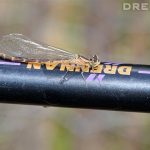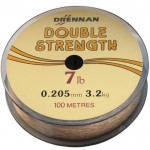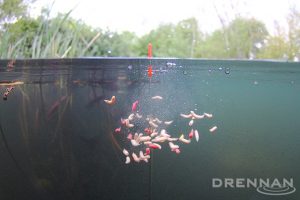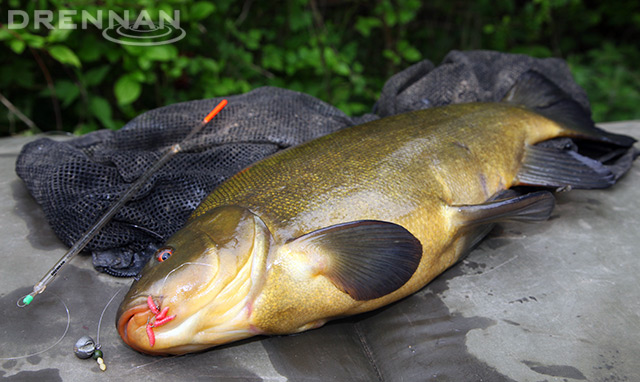Still water specimen hunting is predominantly based around bolt rigs and buzzers, which is understandable given its effectiveness. Not only is this true for carp but tench as well.
There is a period, generally, from mid-May onwards, where a more traditional approach will have its day and for once the scream of an alarm won’t indicate success but instead the dip of a float, giving you one of angling’s classic moments with the lift method.
 Generalising is a dangerous thing but at the start of the tench season with the water still cool they remain within reach of only a feeder. Longer days, higher temperatures and in my experience, damselflies emerging change the tinca’s habits and now the margins become a favoured place suddenly richer in natural food. At such close quarters the bolt rig loses its impact and if you know how to fish the float correctly you will catch far more.
Generalising is a dangerous thing but at the start of the tench season with the water still cool they remain within reach of only a feeder. Longer days, higher temperatures and in my experience, damselflies emerging change the tinca’s habits and now the margins become a favoured place suddenly richer in natural food. At such close quarters the bolt rig loses its impact and if you know how to fish the float correctly you will catch far more.
 The perfect scenario for me is to arrive the evening before to utilise another method many would believe belonged in a museum – the rake. In fact, it’s 2 stainless steel rake heads placed back-to-back and wired together. It’s important they are heavy hence the stainless steel so they tear into the bottom and not skip over it. Once tied on the end of a length of rope it can be thrown to the base of the marginal shelf.
The perfect scenario for me is to arrive the evening before to utilise another method many would believe belonged in a museum – the rake. In fact, it’s 2 stainless steel rake heads placed back-to-back and wired together. It’s important they are heavy hence the stainless steel so they tear into the bottom and not skip over it. Once tied on the end of a length of rope it can be thrown to the base of the marginal shelf.
I will do this regardless of whether there is weed or not because just the action of turning over the bottom is highly attractive. Is this due to the fact that natural food is released? Yes, but I believe, crucially, the shine from a freshly turned bottom is also very attractive as it looks as if other tench have been feeding there and makes it worth investigating. This is boosted further by a little pre-bait and if small fish aren’t an issue maggots or caster and hemp combo would be my first choices, only if necessary to avoid small silverfish pellet or corn would be added. Whatever is selected it wouldn’t be much and certainly no more than half a pint. Once prepared the night would be a relaxing affair as I wouldn’t be fishing.
 Dawn onwards is the time to wet a line and the tackle to do so starts with my all time favourite rod – the Drennan tench float with its classic forgiving action perfect for close quarter battles and teamed with a Double Strength reel line of 7lbs. Many anglers struggle with pre-stretched lines but you won’t have any issues if you avoid the following. Any knot that chokes itself, a palomar being by far the best knot to use, shot will also weaken the line, especially with today’s sharp-edged lead-free versions and finally hook lengths where you have 2 fixed points, ie a hook and a swivel. With little or no stretch, which monofilament gains much of its strength from, 7lbs will suddenly be more like 3lbs. So why bother? Learn how to use it and presentation is unbeatable.
Dawn onwards is the time to wet a line and the tackle to do so starts with my all time favourite rod – the Drennan tench float with its classic forgiving action perfect for close quarter battles and teamed with a Double Strength reel line of 7lbs. Many anglers struggle with pre-stretched lines but you won’t have any issues if you avoid the following. Any knot that chokes itself, a palomar being by far the best knot to use, shot will also weaken the line, especially with today’s sharp-edged lead-free versions and finally hook lengths where you have 2 fixed points, ie a hook and a swivel. With little or no stretch, which monofilament gains much of its strength from, 7lbs will suddenly be more like 3lbs. So why bother? Learn how to use it and presentation is unbeatable.
 The float goes on first, which is always a Crystal Waggler, the length increased with depth and surface tow experienced. The tip can also be changed and it’s amazing how often a black one can stand out better than orange. As I have already said I avoid shot so a silicon sleeve is used to attach the float to the line and hold in position. This arrangement is also beneficial should the float become snagged in weed suddenly giving a fixed point between the fish and the float, but instead of breaking the line it will easily pull off.
The float goes on first, which is always a Crystal Waggler, the length increased with depth and surface tow experienced. The tip can also be changed and it’s amazing how often a black one can stand out better than orange. As I have already said I avoid shot so a silicon sleeve is used to attach the float to the line and hold in position. This arrangement is also beneficial should the float become snagged in weed suddenly giving a fixed point between the fish and the float, but instead of breaking the line it will easily pull off.
 The terminal end also follows my golden rules and the anchor weight is supplied via an X2 or X3 swan shot that is pinched on braid which has been passed through a small ring. This can now slide up and down the line with zero chance of damage. Of course, it needs to be fixed in position and I do this with a small bead and 2 Float Stops, this sets the distance of the hook length without a swivel in sight. The only knot in the entire rig is the one I use to attach the hook with the first fixed point at the reel and even that has a forgiving clutch as well as the bend of 12 feet of carbon to stop breakages. Hook size depends on bait but is always a Super Specialist, a 12 to 16 for caster and maggot or a 10 to 14 for pellet and corn.
The terminal end also follows my golden rules and the anchor weight is supplied via an X2 or X3 swan shot that is pinched on braid which has been passed through a small ring. This can now slide up and down the line with zero chance of damage. Of course, it needs to be fixed in position and I do this with a small bead and 2 Float Stops, this sets the distance of the hook length without a swivel in sight. The only knot in the entire rig is the one I use to attach the hook with the first fixed point at the reel and even that has a forgiving clutch as well as the bend of 12 feet of carbon to stop breakages. Hook size depends on bait but is always a Super Specialist, a 12 to 16 for caster and maggot or a 10 to 14 for pellet and corn.
 At this point the tackle is ready but plumbing up is still required as is the crucial decision of where to place it down the marginal shelf. I always look to fish over depth by a float length and a half and this is easily done with the silicon tubing arrangement. On a gentle gravel pit shelf, I will fish three-quarters of the way down where the substrate is still firm. It’s tempting to fish at the bottom of the shelf especially if you see bubbles here but over the years silt and debris collects at the base which encourages filter feeding and can give a day of frustrating line bites. It’s far easier to catch a tench on a gravel bottom.
At this point the tackle is ready but plumbing up is still required as is the crucial decision of where to place it down the marginal shelf. I always look to fish over depth by a float length and a half and this is easily done with the silicon tubing arrangement. On a gentle gravel pit shelf, I will fish three-quarters of the way down where the substrate is still firm. It’s tempting to fish at the bottom of the shelf especially if you see bubbles here but over the years silt and debris collects at the base which encourages filter feeding and can give a day of frustrating line bites. It’s far easier to catch a tench on a gravel bottom.
 Once ready to fish I cast into position, place the rod on 2 rests close at hand before winding down gently and cocking the float. It’s now like a set trap waiting to spring into action either confidently plunging away or giving the most romantic bite of all – a lift. The tip quivers and then in a steady motion rises into the air.
Once ready to fish I cast into position, place the rod on 2 rests close at hand before winding down gently and cocking the float. It’s now like a set trap waiting to spring into action either confidently plunging away or giving the most romantic bite of all – a lift. The tip quivers and then in a steady motion rises into the air.
The window of opportunity for this type of fishing is very small and I suggest you don’t miss it over the next few weeks for its one of the joys of spring.
Martin’s Top 5 Tips
- It’s crucial where you fish down the marginal shelf and 90% of the time I would avoid the base.
- When fishing maggots I like to combine it with an artificial Buoyant Maggot on the hook to critically balance it.
- For really crafty fish use a PVA mesh bag of freebies nicked on the hook for pin-point baiting.
- Try adjusting the hook length as every day will see different behaviour from the tench.
- Surface tow on large pits can drag your float under and to combat this use the longest Crystal Waggler available.


